HUNGARIAN photographer Tom Kublin had a great influence on fashion photography, working with houses like Dior, Givenchy and Yves Saint Laurent. However, it is his collaboration with Spanish couture designer Cristóbal Balenciaga that produced some of his most significant work and influenced the genre.
Kublin was born in 1924 in Zalaszentgrót, a small town in Hungary. He was obsessed with photography from a young age – setting up a dark room in his parents’ bathroom. When he was 15, he studied photography at the Budapest School of Photography and during the Second World War he took photos of the bomb-devastated city for the Hungarian army.

Tom Kublin behind the Camera, 1965. Courtesy Maria Kublin
With Hungary still reeling from the fall out of war, he moved to Zurich in 1951 and set up a photographic studio. At the time, the Swiss city was famous for its textile industry and Kublin worked for the Abraham silk company, which supplied Parisian Haute Couture houses, photographing fabric.
It was through this that Kublin began working with Cristóbal Balenciaga photographing the designs of each of his collections for copyright purposes, as was commonplace in Haute Couture. This began their mutually creative relationship.
Kublin went on to shoot many Balenciaga looks for magazines such as Harper’s Bazaar where he was a favourite photographer of its fashion editor, Diana Vreeland, developing an elegant style that focussed on the garment rather than the model and mise en scène. Working in moving images, he also filmed Balenciaga’s fashion shows and a commercial for Balenciaga’s Le Dix perfume, which was restored for the exhibition Tom Kublin for Balenciaga: An Unusual Collaboration at the Cristóbal Balenciaga Museum.

Maria Kublin. Courtesy Maria Kublin
Tragically Kublin died at the age of 42, too early for his significance in photography to be fully recognised.
His posthumous – and only child – Maria Kublin (her mother, Kublin’s muse, the Dutch model Katinka Bleeker, was six months’ pregnant with her when Kublin suddenly died in 1966 in Locarno, Switzerland) has collaborated with Ana Balda on a book focussing on his work with Balenciaga, Balenciaga – Kublin: A Fashion Record, published by Thames&Hudson.
How did the idea for a book about your father’s collaboration with Cristóbal Balenciaga originate?
In 2022, my co-author, Dr Ana Balda, and I curated an exhibition for the Cristóbal Balenciaga Museum, Tom Kublin for Balenciaga: An Unusual Collaboration. From the outset, it was the intention to emphasise the extraordinary collaboration between my father, Tom Kublin, and renowned Haute Couture designer Cristóbal Balenciaga. To do so, the exhibition showed more than 100 photographs and five short films, all shot by Kublin for Balenciaga.
Our initial idea was to have a catalogue coinciding with the exhibition, but as we were living in uncertain times – due to the pandemic – it just didn’t happen. The fact that the exhibition was extended because it was such a success gave us the confidence that people were interested in the creative relationship between my father and Balenciaga. And so, the idea of a making a book came into existence.
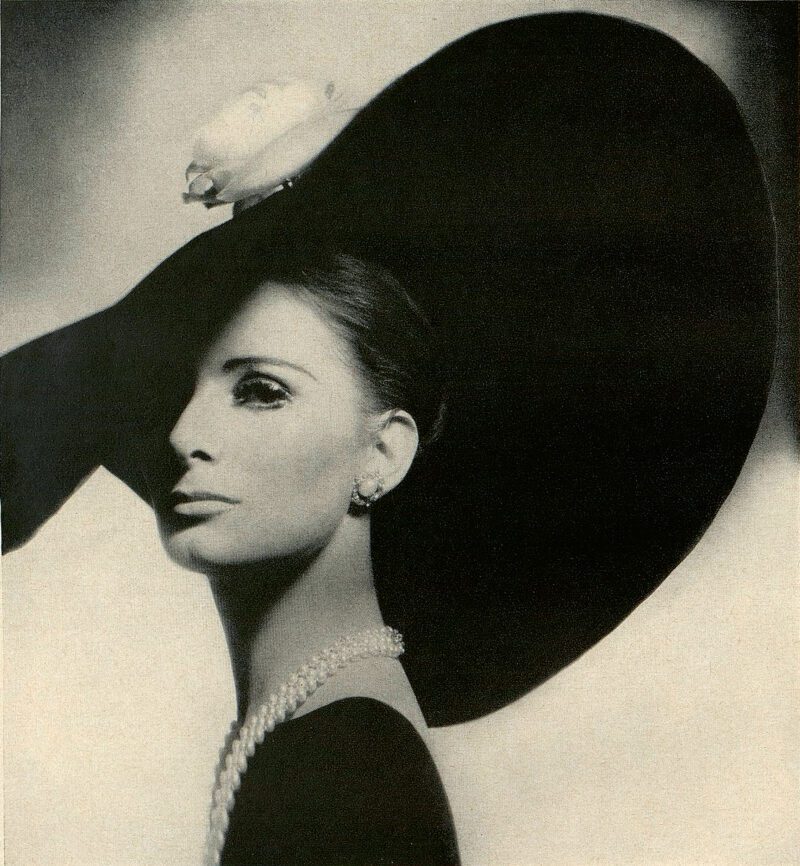
June 1965, Harper’s Bazaar US. Courtesy Hearst Magazine Media Inc
The book also contains an interview with your mother, Katinka. Can you explain how this idea evolved and how you felt interviewing your mother?
As previously mentioned, Balenciaga-Kublin: A Fashion Record was written by two authors each with a distinctive approach: Ana Balda was responsible for writing the biography of my father. Being the posthumous daughter of Kublin, I was eager to give a more personal perspective and interviewing my mother Katinka Bleeker, model and muse, seemed a logical thing to do. Being able to interview my mother was an enriching experience as it gave me an insight into her life as a young girl from Amsterdam who moved to New York City in the 1950s with a dream of becoming a model and where she met my father.
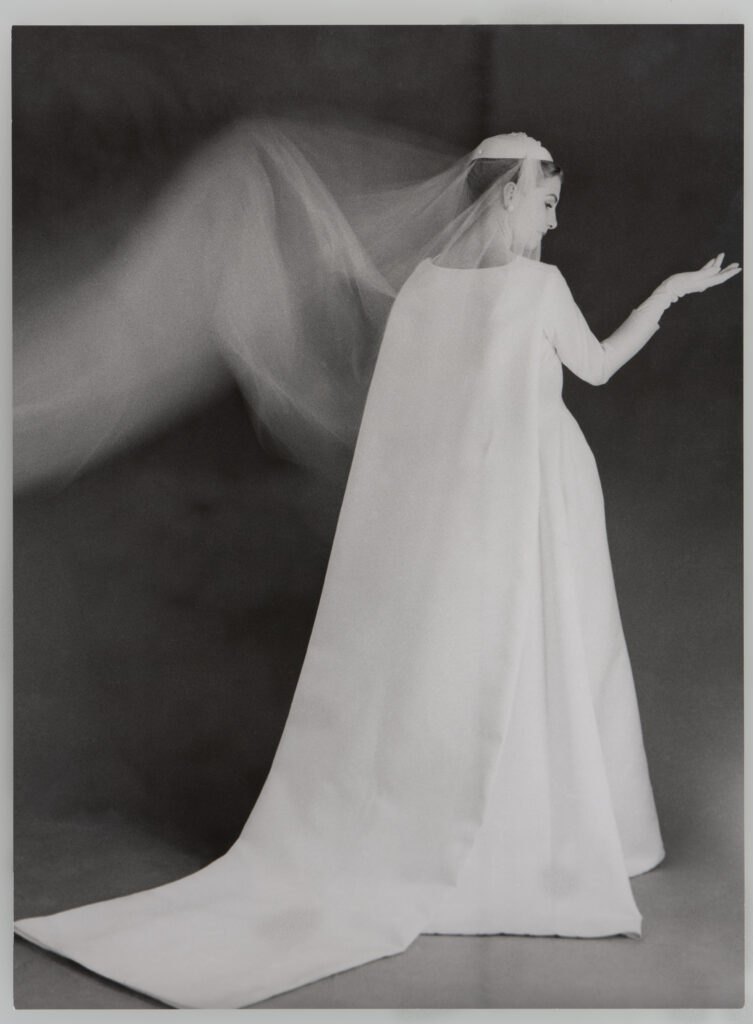
1955, Abraham Textile Archive. Courtesy Abraham Textile Archive, Swiss National Museum, Zurich
Did you and your mother have all his archive when he died or did you have to seek it out?
After my father passed away, my mother was left with the archive. For many years it was just there. My mother was so overcome with grief that looking at the photographs was too painful for her. It took a few years before she was able to look at my father’s body of work and, of course, also look at herself as a model. For me, the archive became a very important source once I dived into the legacy of my father. Discovering a filmed commercial for Balenciaga’s Le Dix perfume, starring my mother, was an absolute highlight. This film had never been seen by the public before and was shown for the first time in the exhibition.
While doing your research, did you find new information about your father?
In 1971, the BelleriveMuseum in Zurich dedicated a first retrospective exhibition to Balenciaga. During my research, I came across a letter written by Diana Vreeland in which she writes to the curator of this exhibition, asking politely but determinedly, if she could include the photographs and films of her dear friend Tom Kublin in her 1973 exhibition The World of Balenciaga at the Metropolitan Museum of Art. Of course, she was permitted to do so.
Besides working with Balenciaga, my father worked for Dior, Chanel, Givenchy and Yves Saint Laurent, among many others. The Musée Yves Saint Laurent in Paris has a letter from Yves Saint Laurent to my father saying how he values their friendship and collaboration. Knowing that the work of my father was appreciated by important figures in fashion has filled me with joy and pride.
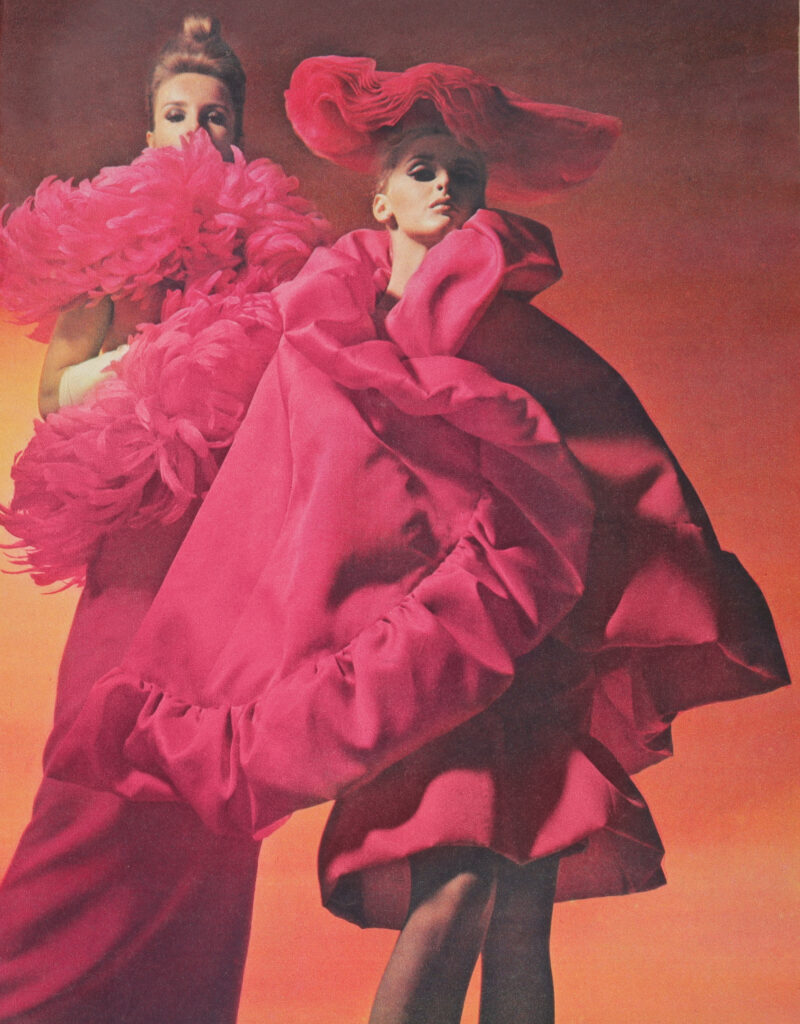
September 1965, The Weekend Telegraph. Private Collection
Could you describe the essence of your father’s collaboration with Cristóbal Balenciaga and why it was so fruitful?
It is not easy to explain how two creative people understand each other so well. It is interesting that they had a similar upbringing: both knew from a young age what they wanted to become later in life; were exposed to grandeur; lost their father [early in life] and had to flee their country because of political turmoil.
Perhaps this almost identical background was at the basis of it all. When my father met Balenciaga, he was still in his 20s and Balenciaga, being older, might have mentored the young Kublin by taking him, for example, to art galleries and museums where he introduced Kublin to Spanish artists like Goya and Zubarán.
I can imagine that through these museum visits and conversations, my father developed a certain taste, which eventually developed into a shared vision and visual dialogue that enabled both to learn from each other and for Balenciaga to see his designs in a fresh and different way. The collaboration between Tom Kublin and Cristóbal Balenciaga is significant both in documentary and artistic purposes with the importance of the photographic and filmic work in shaping the image of the Balenciaga brand.
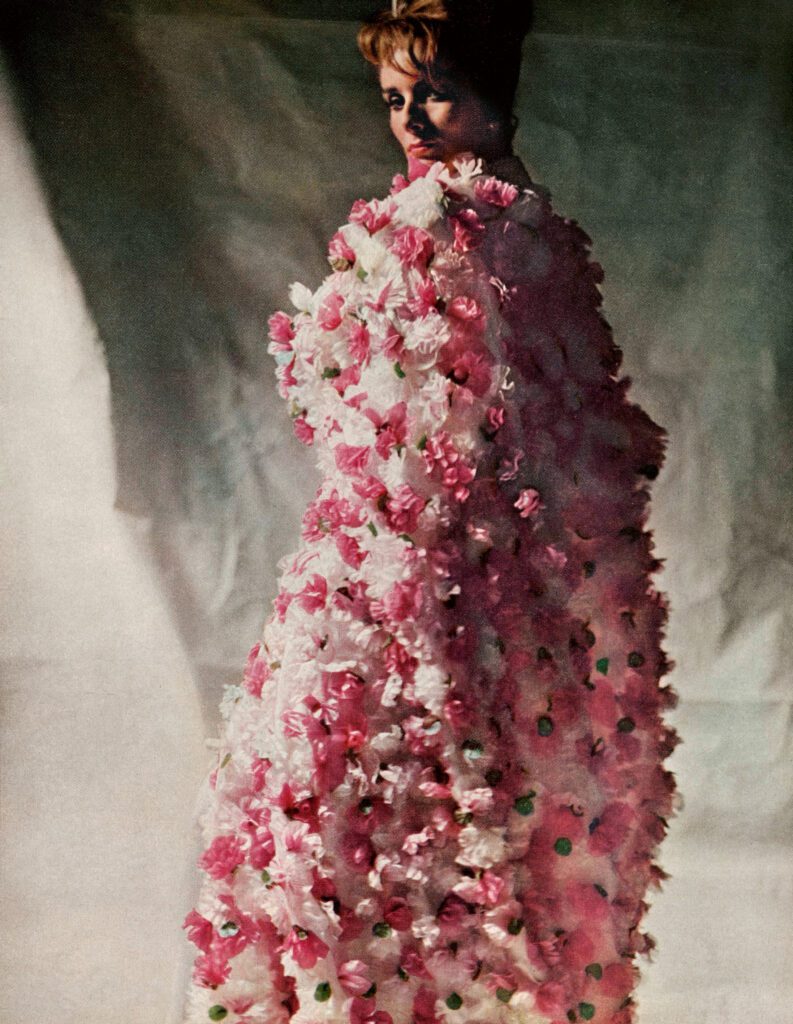
July 1964, Harper’s Bazaar US. Courtesy Hearst Magazine Media Inc
Balenciaga was heavily influenced by art. After seeing his oeuvre, would you say this also applies to the work of your father?
My father had his first studio in Zurich, Switzerland, at the time the world capital for silk companies. At its highpoint, the city had more than 90 silk businesses and one of these companies was Abraham, whom my father worked for, photographing their fabrics. The director, Gustav Zumsteg, was a visionary and his best clients were Balenciaga, Givenchy and Yves Saint Laurent.
Zumsteg’s mother was the propriétaire of Kronenhalle, a restaurant where avant-garde artists, Haute Couture designers and my father mingled. Being an art historian, I can definitely see that he was influenced by art. A great example is a photograph he took for Harper’s Bazaar [1959] of the ballerina Antoinette Sibley and a sketch from an Edward Degas portfolio which was in my father’s art collection. The composition, the pose of the ballerina and the atmosphere of the image are strikingly similar. We also discovered that the dramatic draped fabrics he used as a background for many editorials was inspired by Da Vinci’s Drapery for a Seated Figure.
What can you tell us about your father’s development as a photographer?
Of course, I know my father’s body of work very well but sometimes I am surprised by discovering a photograph that was previously unknown to me. His development as a fashion photographer and filmmaker became evident at the show at the Cristóbal Balenciaga Museum. Being able to see his career showcased in chronological order gave such a great overview, showing how he evolved and developed his signature style. This was also the case with his fashion films. His first films are a bit stiff in comparison to his later ones, which show off his confidence and artistic skills.
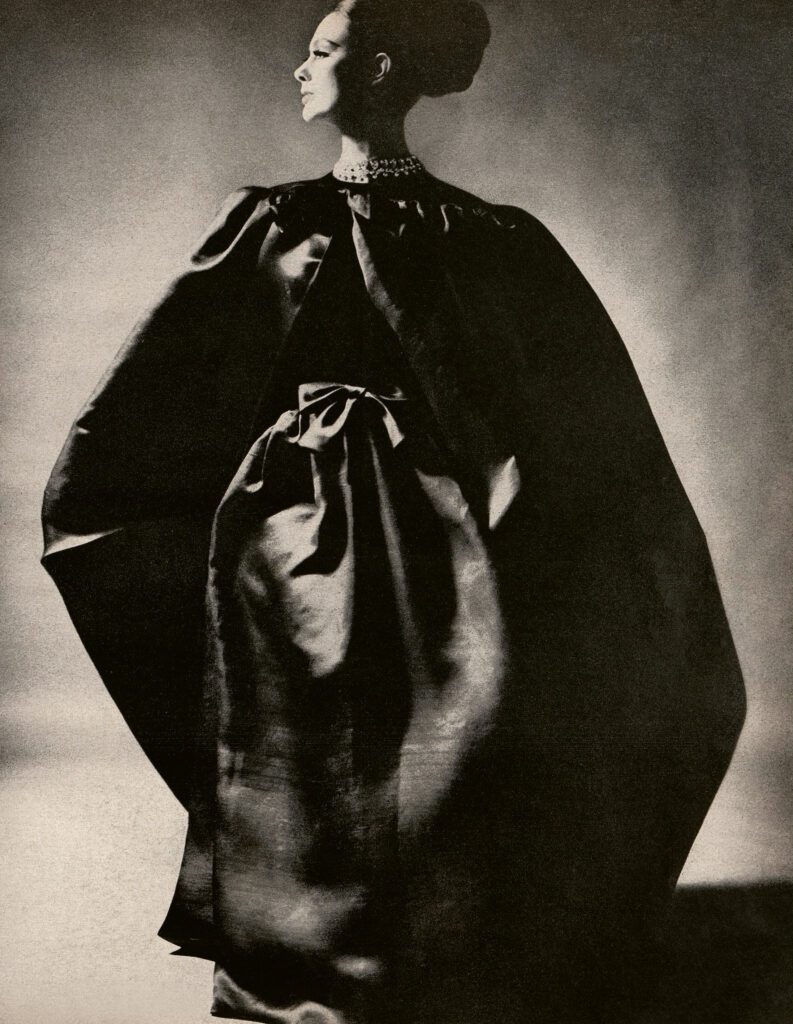
November 1963, Harper’s Bazaar US. Courtesy Hearst Magazine Media Inc
How do you think Tom Kublin influenced fashion photography?
Simplicity is the ultimate sophistication and Kublin understood that. In the isolation of his studio, Tom Kublin created his own world with his own aesthetic, which happened to be in harmony with the Balenciaga aesthetic.
He was a master at capturing timeless beauty resulting in images of classical simplicity. Kublin’s breathtaking portrait of my mother and muse, Katinka [for Harper’s Bazaar, 1965] marks a legacy of timeless photographs that captured an unexpected beauty and the essence of the golden age of couture.
Fashion photography before my father’s time depended on lavish decoration and extravagant poses. In Kublin’s work, there are, for example, no settings, only the model and the dress. By emphasising style over context, he revolutionised the genre.
Do you have any future plans for keeping your father’s legacy alive?
I would love to introduce my father’s work to the greater public and I think that creating this book definitely helps. In collaboration with my publisher, Thames&Hudson, I have been extremely lucky to be able to do book-related events – for example a talk at the V&A in London in October. I can hardly describe how good it feels to talk about my father’s legacy and receive such positive reactions. Of course, I would like another exhibition and am currently in conversation with several important art institutions. So let’s see what the future has in store.
by Caroline Simpson
Balenciaga – Kublin: A Fashion Record by Ana Balda and Maria Kublin is published by Thames&Hudson
